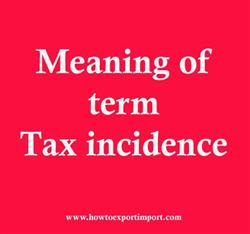Term Tax incidence
The details about Tax incidence are explained here.
Incidence tax
A tax incidence is an economic term for the division of a tax burden between buyers and sellers. Tax incidence is related to the price elasticity of supply and demand, and when supply is more elastic than demand, the tax burden falls on the buyers. If demand is more elastic than supply, producers will bear the cost of the tax.
 BREAKING DOWN 'Tax Incidence'
BREAKING DOWN 'Tax Incidence'
The tax incidence represents the distribution of the tax obligations that must be covered by the buyer and seller. The level at which each party participates in covering the obligation shifts based on the associated price elasticity of the product or service in question as well as how the product or service is currently affected by the principles of supply and demand.
Price Elasticity
Price elasticity is a representation on how buyer activity is changed in response to a change in the price of a good or service. In situations where the buyer is likely to continue purchasing a good or service regardless of a price change, the demand is said to be inelastic. When the price of the good or service highly impacts the level of demand, the demand is considered highly elastic.
Examples of fairly inelastic goods or services can include gasoline, electricity and cigarettes. Even if prices change, the level of consumption across the economy remains fairly steady in all of the aforementioned examples. Elastic goods are those whose demand is greatly affected by price. This can include many luxury goods, such as precious metals, as well as large purchases, such as housing, and those with a variety of price points to choose from, such as clothing.
Analysis of Tax Incidence
Tax incidence reveals which group, the consumers or producers, will pay the price of a new tax. For example, the demand for cigarettes is fairly inelastic, which means that despite changes in price, the demand for cigarettes will remain relatively constant. Let's imagine the government decided to impose an increased tax on cigarettes. In this case, the producers may increase the sale price by the full amount of the tax. If consumers still purchased cigarettes in the same amount after the increase in price, it would be said that the tax incidence fell entirely on the buyers.
If a new tax was levied on a more elastic good, such as fine jewelry, the majority of the burden would likely shift to the producer as an increase in price may have a significant impact on the demand for the associated goods.
The information on Tax incidence is detailed above. Comment below your thoughts on Tax incidence
Learn Exports Imports Free, Click here
Click here to know GST rate of your goods or service
CGST Act section 101 Orders of Appellate Authority
CGST Act Section 102 Rectification of advance ruling
CGST Act Section 103 Applicability of advance ruling
CGST Act section 104 Advance ruling to be void in certain circumstances
CGST Act Section 105 Powers of Authority and Appellate Authority
CGST Act Section 106 Procedure of Authority and Appellate Authority
CGST Act Section 107 Appeals to Appellate Authority
CGST Act section 108 Powers of Revisional Authority
CGST Act Section 109 Constitution of Appellate Tribunal and Benches thereof
CGST Act Section 110 President and Members of Appellate Tribunal, their qualification, appointment, conditions of service
CGST Act section 111 Procedure before Appellate Tribunal
CGST Act Section 112 Appeals to Appellate Tribunal
CGST Act section 113 Orders of Appellate Tribunal
What is SGST Law under GST
Term SGST under GST
What is apportionment of tax and settlement of funds under GST
Import Customs procedures in Importing country
How to export goods, step by step information
Documents required for exporting
Meaning of Inverted duty structure
Meaning of Intimation for composition levy
Interstate trade or commerce means
How to import to India from Norway?
How to export from India to Norway?
How to import to India from Lithuania?